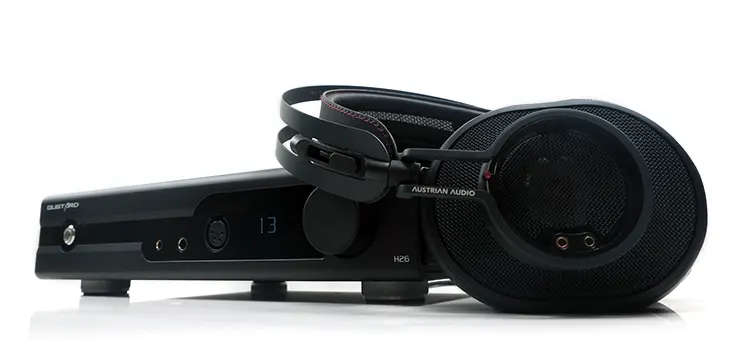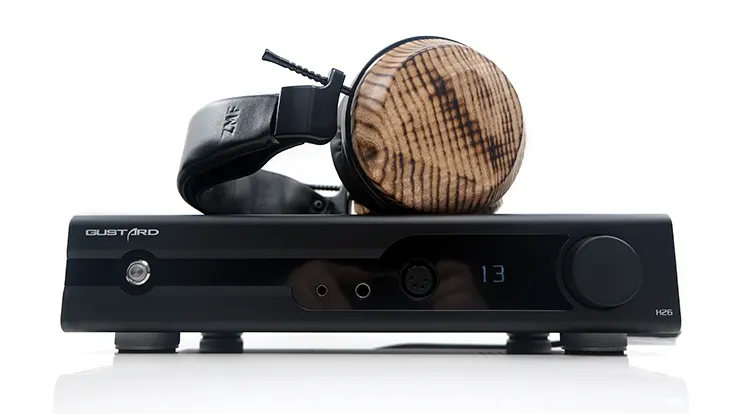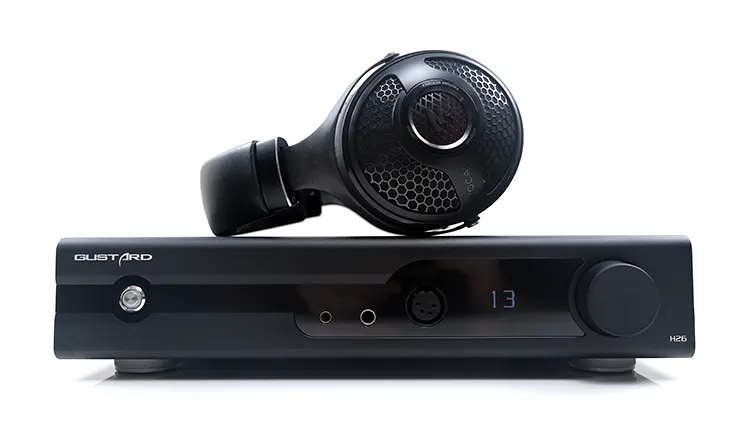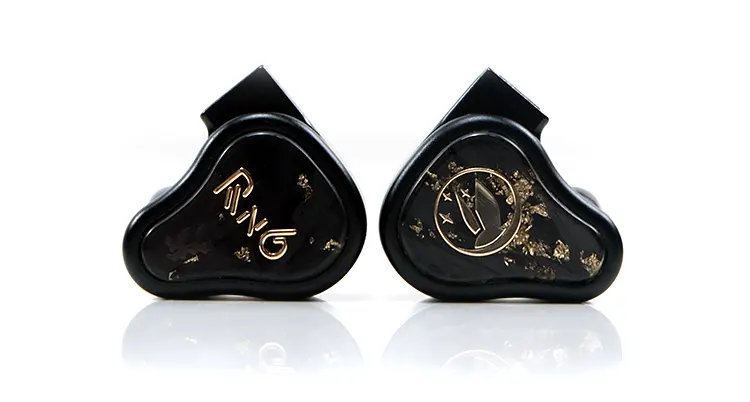Sound Impressions
The following sound impressions of the Gustard H26 were completed using a mix of the Topping DX9, the LP P6 Pro, and the Cayin N8ii as the main DAC and transports.
Headphones used include the Austrian Audio Composer, ZMF Headphones Caldera Closed, and the Dan Clark Audio E3 in a balanced high-gain configuration.
Summary
The H26 delivers a smooth and very spacious-sounding performance with pretty much every headphone I tried it with.
The general note weight and imaging are neutral or just slightly above with a pleasing sliver of warmth, particularly in the upper bass and lower mids.
It is not as beefy sounding on the lows or as bombastic in the mids as some competing amplifiers such as the Prelude or the Anni. Nor do I find it as clean and precise as the OOR from Ferrum.
However, it is far airier than the 3 compared amplifiers above, stretching the stage much wider and deeper creating a very elaborate presentation that I find excellent for open-sounding headphones and IEMs.
It also creates a beautifully smooth leading note edge and unflappable treble overtone making even the most strident of vocal and percussion deliveries so easily digestible. DCA E3 owners take note, this is an excellent pairing sounding clear but quite pure and slick in tone with excellent channel separation.
I should caveat the above descriptors with an observation on the choice of DAC to create that impression.
Much of that excellent channel separation and impressive staging width is driven in part by my paired DAC, the Topping DX9 which I have already considered as a great DAC for staging in my review of it a few weeks ago.
The H26 is very responsive to what the corresponding DAC brings to the table. Feed it a strong voltage LO of 4Vrms + via its balanced input and it will respond in kind with an equally dynamic performance.
Undercook the voltage or pair it with a DAC with a weaker LO such as the Ladder Schumann will have you reaching for the volume and dealing with a shrunken soundstage and muted dynamics.
Coloration
The H26 can be described as a smooth-sounding amplifier but the general tonal quality is not what I would call dense and rounded. Rather, it’s slightly sweetened and can stray to slightly euphonic depending on the headphones and DAC attached.
Bass density and elevation are relatively neutral, at least when compared to the likes of the beefier Prelude and Anni tuning.
The H26 can extend deep and punch when required, more so when the input voltage from the DAC is 4Vrms or higher but it’s still what I would consider as eloquent and tastefully done with a stronger focus on keeping low-end shape and great layering.
The headroom and general treble extension are very impressive, more so for the fact it is not overly strident, even with a clean and neutral DAC behind it.
Only on the odd occasion could I pick up on a slightly harder edge on vocal notes the Composer and that was usually with neutral to DACs with lower-end Sabre DAC chipsets.
You can stiffen the coloration with a thicker-sounding DAC such as the LP P6 Pro or the Ladder Schumann, two R-2R sources known for a richer analog sound signature.
I enjoyed switching to the LO of the P6 Pro with the H26 and Susvara combination. It is not as detailed or atmospheric as the H26/DX9 combo but the note density was more authoritative for bass and lower-mids instruments.
Staging & Dynamics
The staging size and dynamic range level from the H26 is one of its key strengths, particularly with an already ‘wide sounding’ DAC behind it such as the DX9 or the Holo Audio Spring 2.
You get a wonderfully airy atmospheric quality making it an excellent choice for equally open or precise headphones that deliver a good transient response. Even closed headphones such as the Caldera Closed delivered the goods in terms of openness and channel separation with the H26.
The one weak spot might be the best depth and power and to a lesser extent the vocal imaging depending on your preference.
The bass response extends beautifully but the weight and amplitude are more controlled when compared to the likes of the Prelude, OOR, and the Anni. The vocal imaging is also quite neutral though it benefits from excellent space beside and around it so it sounds more relaxed and pure in its delivery than rich and intimate.
I have no issues with dynamic range with the right DAC, rather, it’s not in your face for both sub-bass rumble and mid-bass punch. If you are after a mosh-pit in-your-face experience for your listening session the H26 is not it.
Arena-level performances or high-ceiling hall recordings where you want to hear every nuanced detail across the stage are more the H26’s forte.
Synergy
Power
The H26 is rated on paper at 12W into 32Ω which I presume is from its balanced output on high gain mode and one of the most powerful headphone amplifier ratings I have encountered.
Curiously, it comes with a caveat of 6W maximum undistorted power on the same load which I presume is more likely your ceiling for headphone output before things break up a bit.
The sweet spot for a lot of my headphones such as the Susvara is closer to the 7350mW for a 64Ω, (is that lower for undistorted?) and 1576mW for my 300Ω ZMF Headphone dynamic driver collection and Sennheiser models such as the HD 660S2. On paper at least, these seem good numbers for the H26 driving capability.
So, the big question is can it drive the Susvara? The short answer is yes, and quite well but to get there you need a DAC with a solid Vrms lineout and the high gain setting turned.
You will also need the volume levels turned up quite high due to the logarithmic nature of the matrix relay volume control.
As you will read below, the H26 can give you plenty of volume headroom for sensitive IEMs but for big rigs like the Susvara and other demanding headphones you will have to go a long way up to get the right volume levels.
It’s not unheard of, to be honest. All my dCS amplification such as the Bartok Apex and the Lina have similar non-linear volume systems with a -99 dB to 0 dB range and the Susvara drives quite happily at -16 dB with the H26 on 84/100 steps balanced receiving the DX9 4.4Vrms balanced LO.
Headphone Pairings
There is a core tuning from the H26. It is smooth, evenly weighted on the lows, warm to natural at times but with a sweetness in the highs and some nice, refined sparkle.
The DAC connected to it will enhance some aspects or detract depending on the rated Vrms and its core sound signature.
HIFIMAN Susvara
For example, going balanced with the Topping DX9 lineout combined with the Susvara and the H26 has no issues with power, and it’s a beautiful pairing in terms of channel separation with excellent width and clean, pure vocal performances.
With the LP P6 Pro balanced lineout, the H26/Susvara pairing staging width shrank a little in comparison to the DX9. However, in return, you get a bit more warmth and body on the lows and mids creating a smoother but beefier tone that I preferred for some higher pitching vocal performances.
With the DX9 as the DAC, the H26’s upper-mids sounded a little harder-edged for vocals. However, the dynamics and airiness this pairing produced were more impressive than the P6 Pro/H26 setup.
The Susvara thrives on air and speed so I am prepared to lose a little beef on the lows in return for the better speed from the DX9/H26 system over the slower juicier P6 Pro.
Dan Clark Audio E3
That is a continuing theme with the next two headphones, the Dan Clark Audio E3 and the Austrian Audio Composer.
The E3 was perhaps my favorite pairing. Volume dropped about 10 steps from the Susvara with a low-end that I found pleasingly lifted from the same DX9 DAC input. At the same time the response speed, clarity, and staging width got a welcome boost without any jarring sharpness in the highs.
Austrian Audio The Composer
The Composer is the easiest to drive out of this headphone lineup at about 50%. This was a pairing that performers a better for higher register vocal performance with a warmer DAC behind the H26.
I felt the DX9 DAC pushed the treble overtones on the H26 a bit too much for the Composer which can be fussier on the upper-mids. With the P6 Pro lineout, it sounded liquid-like and very smooth though not quite as airy as the DX9 combo.
IEM Pairings
The H26 is very IEM-friendly with almost every pairing I threw at it given adequate volume headroom and a not unreasonable default gain floor from zero upwards.
Be it sensitive or inefficient, background hiss was non-existent on low-volumes. I noticed a mute relay on 1 to zero, which will help cut out any unintended noise but once you slip to 1 with sensitive IEMs we are immediately into the music, even on a low gain setting.
However, from 1 upwards the channel balancing was excellent as was the volume control which felt nuanced and linear rather than uneven and aggressive.
Sensitive IEMs such as the Campfire Audio Fathom and Vision Ear’s Phonix need to be in low gain. If you have a source with a bit of variable volume control on the line-out or a preamp function I would tone it down from a default line-out setting to give yourself more volume headroom.
For example, combined with the Luxury & Precision P6 Pro balanced LO the H26 was at a maximum volume of just 10 with the Fathom. However, dropping the default max volume level on the P6 Pro improved volume control immeasurably on the H26.
Conversely, pairings such as the FIR Audio Radon 6, CA’s Supermoon, and the IE 600 had plenty of volume headroom with the IE 600 sounding much happier on a high gain setting and almost 40 steps of volume.
Tonally, the H26 paired with the Radon 6 and the Supermoon pairings were incredibly tight and punchy with some excellent depth from their presentation. The IE 600 lapped up some impressive channel separation from the H26 sounding immersive with excellent staging width.
DAC Vrms Lineout
The H26 response differs depending on the quality of the DAC or source you connect to it.
However, the area I wanted to focus on specifically here is not so much the tonal variation because every DAC has its unique signature IMHO. Rather the lineout and its rated Vrms is a major factor in perceived dynamics and PO output from the H26 to a set of headphones.
For those thinking that the H26 might be lacking in a bit of grunt, I would strongly suggest you check the output voltage of your source’s analog lineout to ensure you get enough power to drive the H26 as this was a fussy synergy area during my testing.
DAC Pairings
For example, I hooked up the H26 to two desktop DACs and two portable DAPs using a mix of balanced XLR and 4.4mm to 4-pin XLR connections and ran the PO with the Austrian Audio Composer.
These included the Ladder Schumann and the Topping DX9 DAC lineout balanced mode as well as the Cayin N8ii and the Luxury & Precision P6 Pro DAP’s 4.4mm balanced LO in a high gain maximum voltage setting.
All four produce a significantly difference level of volume, dynamic range, and perceived resolution, not to mention some tonal changes.
The worst was the Schumann DAC which should be doing around 4Vrms balanced but I suspect it might have a higher-than-average impedance rating, (no specs supplied).
It sounded significantly quieter and less dynamic when compared to the 4.2Vrms DX9 balanced LO equivalent. The only pro on the Schumann side was that nice organic analog tone and denser bass response but it was not enough to sway me from the DX9.
The DX9 was more vibrant sounding, offering improved resolution and space via the H26 without upsetting that smooth and airy sound signature. I also could drop the H26 volume level by around 5-6 steps compared to the Schumann.
The P6 Pro is only 2.45Vrms maximum for its LO with the N8ii at 4Vrms but I honestly thought the P6 Pro connection gave me a lot more body, power, and higher volume levels on the H26 compared to the N8ii LO.
If you want a denser fuller sound then the R2R P6 Pro is a great match. The N8ii works better for me in producing that sweeter bloom through the mids but is missing the weight and punch from the P6 Pro LO/H26 pairing.








